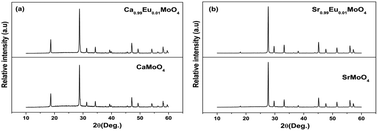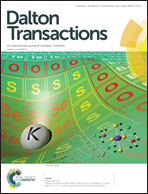Energy transfer dynamics and luminescence properties of Eu3+ in CaMoO4 and SrMoO4†
Abstract
Undoped and europium doped CaMoO4 and SrMoO4 scheelites are synthesized using a complex polymerization method. The phase purity of the sample is confirmed using powder X-ray diffraction (PXRD). X-ray photoelectron spectroscopy (XPS) was carried out to confirm the oxidation states of various constituents and dopant elements and also the presence of oxygen vacancies. Interestingly both CaMoO4 and SrMoO4 on irradiation with UV light give blue and green emission respectively. On europium doping, it was found that molybdate to Eu3+ ion energy transfer is more efficient in SrMoO4:Eu compared to CaMoO4:Eu. It is also justified using a luminescence lifetime study which shows biexponential decay in the case of CaMoO4:Eu corresponding to both the host and europium ion; whereas a single lifetime is observed in the case of SrMoO4:Eu. Anomalies in host–dopant energy transfer are suitably explained using density functional theory (DFT) calculations and XPS. The actual site symmetry for the europium ion in CaMoO4 and SrMoO4 was also evaluated based on a Stark splitting pattern which turns out to be D2 and C2v respectively although it is S4 for Ca/Ba2+ in AMoO4. This is also reflected in higher Ω2 values for SrMoO4:Eu than CaMoO4:Eu.


 Please wait while we load your content...
Please wait while we load your content...